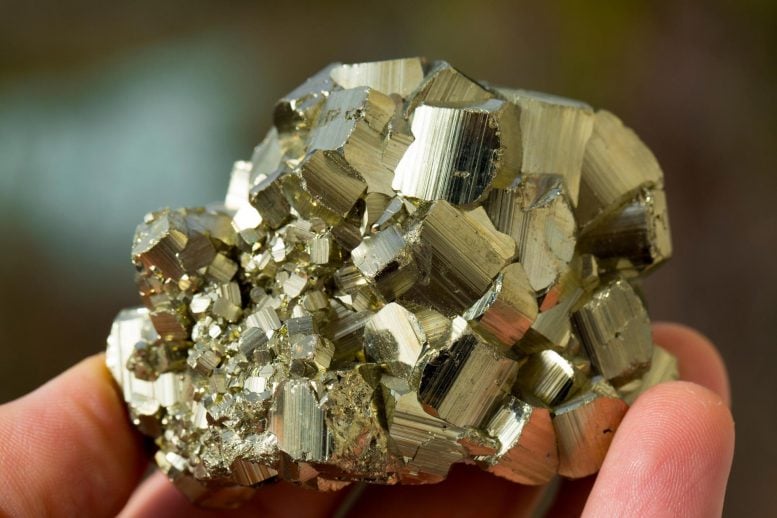
Posted on 06/29/2021 6:39:59 AM PDT by Red Badger

Curtin University research has found tiny amounts of gold can be trapped inside pyrite, commonly known as ‘fool’s gold’, which would make it much more valuable than its name suggests.
This study, published in the journal Geology in collaboration with the University of Western Australia and the China University of Geoscience, provides an in-depth analysis to better understand the mineralogical location of the trapped gold in pyrite, which may lead to more environmentally friendly gold extraction methods.
Lead researcher Dr. Denis Fougerouse from Curtin’s School of Earth and Planetary Sciences said this new type of “invisible” gold has not previously been recognized and is only observable using a scientific instrument called an atom probe.
“The discovery rate of new gold deposits is in decline worldwide with the quality of ore degrading, parallel to the value of precious metal increasing,” Dr. Fougerouse said.
“Previously gold extractors have been able to find gold in pyrite either as nanoparticles or as a pyrite-gold alloy, but what we have discovered is that gold can also be hosted in nanoscale crystal defects, representing a new kind of “invisible” gold.
“The more deformed the crystal is, the more gold there is locked up in defects. The gold is hosted in nanoscale defects called dislocations – one hundred thousand times smaller than the width of a human hair – so a special technique called atom probe tomography is needed to observe it.”
Dr. Fougerouse said the team also explored gold extraction methods and possible ways to obtain the trapped gold with less adverse impacts on the environment.
“Generally, gold is extracted using pressure oxidizing techniques (similar to cooking), but this process is energy-hungry. We wanted to look into an eco-friendlier way of extraction,” Dr. Fougerouse said.
“We looked into an extraction process called selective leaching, using a fluid to selectively dissolve the gold from the pyrite. Not only do the dislocations trap the gold, but they also behave as fluid pathways that enable the gold to be “leached” without affecting the entire pyrite.”
Reference: “A new kind of invisible gold in pyrite hosted in deformation-related dislocations” by Denis Fougerouse; Steven M. Reddy; Mark Aylmore; Lin Yang; Paul Guagliardo; David W. Saxey; William D.A. Rickard and Nicholas Timms, 24 June 2021, Geology. DOI: 10.1130/G49028.1
The study is supported by the Australian Research Council and the Science and Industry Endowment Fund. Dr. Fougerouse is affiliated with The Institute for Geoscience Research (TIGeR), Curtin’s flagship Earth Sciences research institute.
They only told you it was junk all this time so they could buy it up cheap < /barking moonbat >
Wherever you find pyrite,gold is usually nearby.
Translation: We want you to believe real gold is now less valuable so that you’ll quit saving it while we devalue all currencies worldwide.
HUH? I thought(?) the chinese and aussies were at odds with each other.
Where gold is involved, they aren’t....................
Quick! Alert the Hoffmans!
They’ll surely lead us down a path of pyrite. Maybe in French guiana.
They couldn’t find gold in a jewelry store..................
Sorry, but I have to ask:
Why cant we buy wire or sheets of pyrite at the hardware or craft store?
The stuff is gorgeous, shiny and doesn’t rust. Put all that together and it spells: “AWESOME”.
I know there’s a scientific answer to this mystery and somebody around here is bound to know it.
The Hoffmans - perennial Wrong Way Corrigans of gold mining.
You can’t find pyrite in wires and sheets Because it is a crystal and has no ductility. It would crumble into little shards when you tried to shape it.
Well, how much exactly then? Can't be much, or it surely would already have been observed decades or centuries ago. So probably not in the least commercially viable.
Pyrite is very brittle.......................
Regardless of it’s gold content, pyrite has commercial uses:
From WIKI:
Pyrite remains in commercial use for the production of sulfur dioxide, for use in such applications as the paper industry, and in the manufacture of sulfuric acid. Thermal decomposition of pyrite into FeS (iron(II) sulfide) and elemental sulfur starts at 540 °C (1,004 °F); at around 700 °C (1,292 °F), pS2 is about 1 atm.[17]
A newer commercial use for pyrite is as the cathode material in Energizer brand non-rechargeable lithium batteries.[18]
Pyrite is a semiconductor material with a band gap of 0.95 eV.[19] Pure pyrite is naturally n-type, in both crystal and thin-film forms, potentially due to sulfur vacancies in the pyrite crystal structure acting as n-dopants.[20]
Lol. Chinese and Australian “researchers.” Whatever...
Pyrite is very brittle - only found naturally in small irregular crystals. It melts poorly too - Near impossible to get into a sheet (by either melting or by rolling) or extrude into a wire.
Well, it’s because Pyrite only comes in crystal form, if you tried to refine it into a metal that you could make sheets or wire out of, you’d just end up with regular old iron.
I'd always suspected Fool's Gold was up to something.
“The discovery rate of new gold deposits is in decline worldwide with the quality of ore degrading, parallel to the value of precious metal increasing,” Dr. Fougerouse said.
Of course, more than half of the gold ever mined in history has been since the late 1950s, and if put into a single cube, would be about 70 feet on a side (the estimate varies). Within a human lifetime it's likely that a single asteroid doubling the known amount of mineable gold will be discovered, and probably more than one.
Disclaimer: Opinions posted on Free Republic are those of the individual posters and do not necessarily represent the opinion of Free Republic or its management. All materials posted herein are protected by copyright law and the exemption for fair use of copyrighted works.